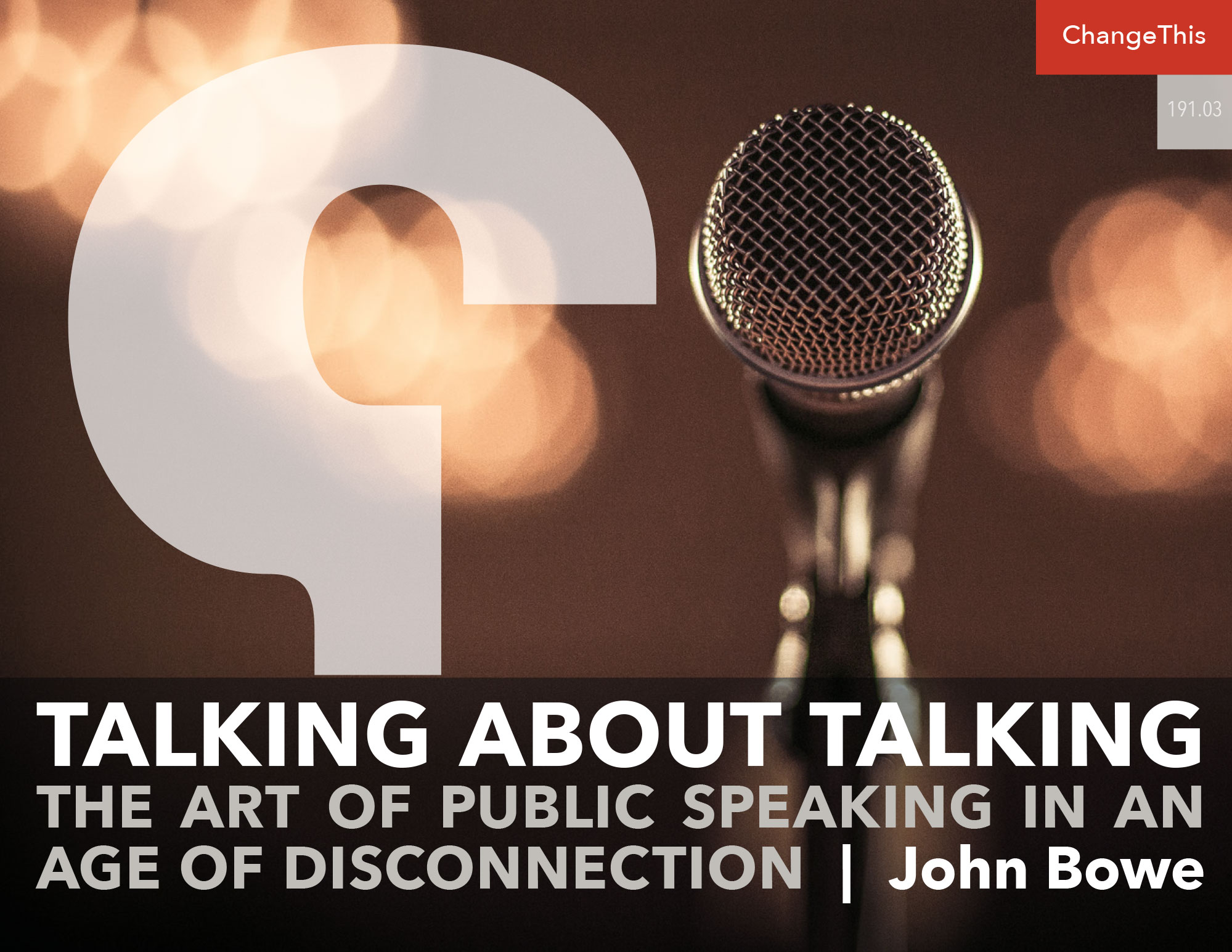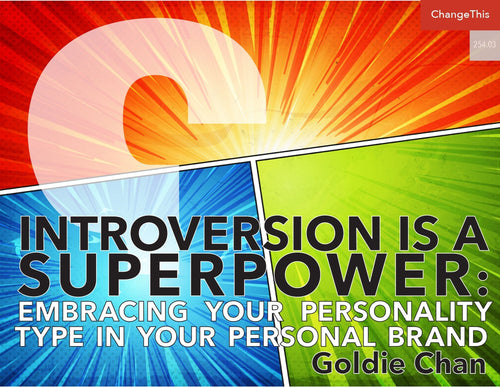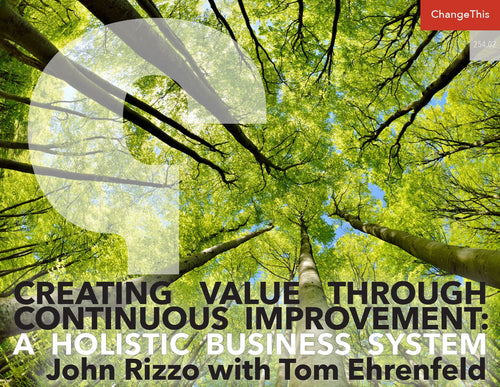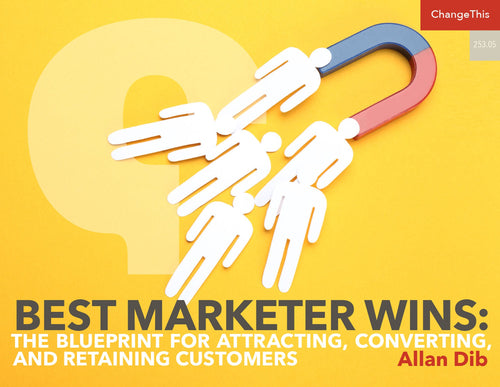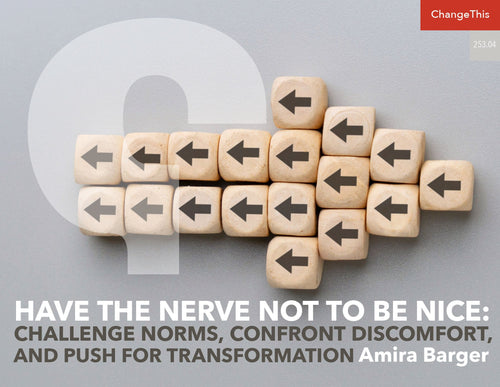Talking About Talking: The Art of Public Speaking In an Age of Disconnection
Few among us talk well or precisely about talking. The subject is too close at hand.
My step-cousin Bill von Hunsdorf grew up in Dyersville, Iowa, an arcadian hamlet of some thousand families surrounded by a sea of corn. In eleventh grade, Bill asked a classmate to prom. She said no. Bill responded by moving to the family basement—and staying there for the next forty-three years.
He went to church now and then, but mostly he lived the life of a recluse. He taught himself to speak German. He learned to play several Chopin sonatas. He spent a decade building a model train set that wound through the entire space, gracing every bend and junction with miniature juniper trees, Old West buildings, and painstakingly detailed figures of human beings.
On the three occasions that I’d met him, Bill engaged in pleasant, if eccentric, conversation. But he remained the most socially isolated person I’d ever known. As family members reported over the years, he’d never been on a date, never kissed anyone, never held another person’s hand, never shared a beer with a friend.
During the 1980s, everyone in Bill’s life began to die: his father, his mother, and finally Karen, the family dog. Bill remained in the family home, year after year—alone. His shyness, long viewed as a harmless quirk, began to seem more like a life sentence of tragic solitude.
In 1992, at the age of fifty-nine, Bill surprised us all by getting married.
I learned through the family grapevine that his wife’s name was Debbie, that Debbie was a nurse, that they liked to go dancing, and that they seemed very happy. What no one could fathom, of course, was how Bill had managed to talk to Debbie in the first place, much less propose to her.
In 2010, Bill and Debbie came to Minneapolis to share Thanksgiving with my family. Eager to learn how he had come out of his shell, I made sure to sit next to him at dinner. I asked him: Had he started seeing a shrink? Had he gone on meds? Nothing of the kind. As the turkey was served, Bill credited his turnaround to a nonprofit organization he’d joined called Toastmasters. Someone at church had told him it was a nice place to meet people.
The name brought to mind other clubs I’d heard of, like the Rotary, the Kiwanis, the Lions. I’d seen signs for them posted outside small towns around the country for as long as I could remember. I seemed to recall that Toastmasters had something to do with speeches, but I knew little else about it.
Bill explained he’d found a Toastmasters chapter that met weekly at the Dubuque Public Library, twenty miles from his home. He liked it from the start. The members were diverse. The fee was affordable: forty-two dollars a year. To his relief, no one forced him to speak. “I didn’t have to jump in until I was good and ready,” he told me. “Which was all to the good, because I was, as you might say, a bit of a delicate petunia.”
Toastmasters meetings typically follow a standard order. They begin with the Word of the Week, which introduces a new vocabulary word. Then there’s the Joke of the Week, when volunteers stand and tell jokes. Next is Table Topics, when participants speak off the cuff about random topics. Finally, there are “prepared speeches,” when members deliver four-to-ten-minute talks. At the end of the meeting, volunteer officers serving as Timer, Grammarian, Ah Counter, and Evaluator report on how long each speaker spoke, any grammatical errors they made, and the number of times they said “ah,” “um,” “like,” and other “crutch” words, then gently offer tips for improvement.
A month after joining, Bill tried his hand at a Table Topic. He sweated, stammered, and shuddered, but resolved to try again. A few weeks later, he began to deliver prepared speeches about technical subjects near and dear to his heart, like how to install a do-it-yourself fuel efficiency monitor in your car. His fledgling efforts, he recalled with a laugh, were far from eloquent, but within a few months, he noted a tremendous improvement—both in and outside of his club.
He’d always felt anxious while talking to strangers. He’d rush his thoughts in a jumble, then become flustered when his listener didn’t understand what he was saying. Through Toastmasters, he explained, he’d learned to pause before speaking to consider how his words might strike an audience. Instead of going on in his usual, dryly technical way, he began to translate his ideas into less obscure terms. Instead of presuming that his listeners would find his obsessions interesting, he began to explain why they were interesting. As people began to understand him better, he told me, conversations—and even relationships— became more fluid.
By now, we’d dispatched the turkey and a raft of Thanksgiving side dishes. The rest of the family had gone for a walk to make room for pumpkin pie, but Bill and I stayed behind. I was captivated by the idea that he’d transformed his life simply by delivering fewer than a dozen amateur speeches. Had learning to speak in public cured him of shyness? I asked. “Heavens no!” he laughed. “I’m still quite shy. Toastmasters did not exactly make me glib! What I learned, you might say, is a method for connecting with people despite my shyness—which, I will say, had a profound effect.”
One Sunday, he went on to explain, two years after joining the club, Bill drove past a nice-looking woman sitting in a park by the Mississippi River. He knew that the park staged singles meets on weekends, so he pulled over, walked across the grass, sat down next to her, and delivered perhaps the most important speech of his life: “Hello. I’m Bill. I noticed you sitting here. It’s such a lovely day. I wondered if you’d mind if I sit here as well.”
Five months later, he and Debbie married.
I found his story profoundly moving. To a typical modern-day urbanite like me—an Internet-and-phone-addicted guy with a busy social life—organizations like Toastmasters seemed like quaint relics from a slower-paced, more congenial era. Why had I, a professed fan of things vintage and warm, never stopped to think about them? In that initial enthusiastic swoon of “discovering” Toastmasters, I imagined the club as a secret underground network of Cousin Bills, of the shyest, least herlded members of American society. In a culture dominated by loud cellphone talkers, reality TV showboats, and social media extroverts who have apparently never endured a timid moment, the existence of such an organization seemed tender beyond belief. But what I, the writer, found most appealing was that words had served as a kind of medicine. Bill had been sidelined, socially self-exiled. Suddenly, he had a life. He had love.
As a journalist, always on the lookout for a new idea to pitch to editors, I began to research the organization in my spare time. Toastmasters International was founded in 1924, in Santa Ana, California, by Ralph C. Smedley, a YMCA executive charged with developing adult education programs. A naturally gifted communicator himself, Smedley noted with concern the plight of students who seemed markedly afflicted by speech anxiety. Industrious, intelligent, or good-natured as they might be, their inability to communicate with ease was robbing them of normal, happy participation in personal and professional life.
As he would later write, “When a man is unable to express his thoughts to his fellows, to express himself vigorously and comfortably in his business and social life, he lives a diminished existence. The greater part of his intellect, his creativity, and his very being lay dormant.”
Far from quaint or out-of-date, I discovered, the organization is more popular than ever in its history, with 358,000 members in virtually every city and county of the United States and 143 countries around the world. Time and again, as I learned more about it, I was stirred by stories like my cousin’s, with formerly isolated, marginalized people describing participation in Toastmasters as a life-changing, quasi-spiritual experience. “It’s Alcoholics Anonymous for shy people,” enthused one. Another called it the cure for the loneliness of the modern world, declaring, “It’s like the opposite of depression.”
I also discovered that shy rural Americans are by no means its only constituency. Chapters meet in prisons and high schools, colleges and seminaries. Hundreds of the world’s most powerful corporations, from IBM to JPMorgan Chase Bank, Google, Apple, Microsoft, Coca-Cola, and Walmart host private in-house meetings. Some have more than one chapter. Bank of America has sixty-three.
As it turns out, the notion of speech education, for shy and “normal” people alike, is far from new. In the fourth century B.c., the ancient Greeks “invented” the subject as part of a larger discipline known as rhetoric. Aristotle defined it as “the ability to discover, in any particular case, the available means of persuasion.”
If it seems odd to consider that such a broad subject could—or would need to—be invented, it helps to imagine the social realities of early democracy. Under the oligarchs who previously ruled the Greek islands with an iron fist, civic discourse was restricted to the likes of Achilles and other military heroes—and virtually forbidden to everyone else. With the advent of free speech, trials, elections, and other forums of self-rule, standing up and speaking to groups of people became, for citizens, a part of everyday life—required, in some cases, by law.
Early rhetoricians saw that certain ways of talking work better than others (telling stories in three parts, to cite an easy example). Studying, naming, and exploiting them, they realized, could transform our ability to make sense, to reach others, and to be known. The ability to influence crowds had, to a large degree, replaced military might as the primary currency of power. The study of speech became, almost overnight, the digital revolution of its day—a locus of intense intellectual activity and a turning point in the way people thought and lived their lives.
For the next two millennia, rhetoric remained a staple of education. Referred to as the “queen of the arts,” it was universally understood to be the essential component of social, emotional, and professional success. In fact, it’s hard to overstate the subject’s preeminence. Western European curricula typically included years of speech training. Through the 1600s, more books were published on rhetoric than on any other subject, save Christianity.
All of which, I now realized, posed something of a mystery. The average American today speaks 16,000 to 20,000 words a day. We depend upon speech—and persuasion—as much as ever to define and explain ourselves, to give and receive orders, to make our case for love, money, and power. But the teaching of rhetoric—and public speaking—has all but disappeared. Modern education curricula train us from the age of five through our late teens and even mid-twenties to read, write, and master the processing of ideas and information on paper. But what about interacting live, with actual humans?
The idea of a nonprofit organization carrying the torch of an obscure, long-lost tradition emphasizing social and interpersonal skills seemed to bear upon every dour preoccupation I’ve ever nursed about modern life, capitalism, and technology.
In the last thirty years, the number of Americans describing themselves as “lonely” has risen fourfold. In the last fifty, the number of Americans who say they have “no one to confide in” has nearly tripled. Since the 1970s, the number of Americans participating in public or civic groups or clubs (like Toastmasters, but also, for example, bridge clubs, political groups, religious organizations, and the PTA) has dropped by 75 percent. Recent surveys find that 65 percent of American millennials “don’t feel confident” in live social interactions. Eight out of ten feel “more comfortable” texting or chatting online than conversing face-to-face.
On a societal level, the current epidemic of toxic partisanship has pundits speaking of civil war. If, as many believe, social isolation and political divisiveness are the big stories of our time, it seems worth asking: What have we lost by doing away with speech education?
For the Greeks, and for Toastmasters founder Smedley, the value of speech instruction extended far beyond mere self-improvement or vocational training. Learning to communicate well, especially with strangers, offers an antidote to alienation. As Smedley would write in his autobiography, Personally Speaking:
All civilization, all progress depends on communication of ideas. . . . I believe that in bringing improvement in the way of “better thinking, better listening, better speaking” to individuals, we are contributing to the improvement of the society. Toastmasters International can be a powerful force for the improvement of world conditions. The nation needs our services, and so does the whole world.
I was moved and inspired by this spirit of practical optimism. Here was a group of people who, bucking the rage for electronic communication, deemed it worth the trouble to travel with real bodies, in real time, to meet in person and practice the bygone art of talking face-to-face. At first, I’d seen the club as dorky but fascinating. Now it began to seem almost avant-garde.
I wrangled an assignment from The New York Times Magazine to travel to Las Vegas to observe Toastmasters’ World Championship of Public Speaking. Curious to learn more about the organization, I began to visit club chapters in New York, California, Wisconsin, Florida, and Louisiana. At every event and meeting, members shook my hand, looked me in the eye, handed me business cards, and said, “Feel free to ask about anything you want. Would you like to join us?” I’d never come across a group of people so friendly, warm, and polite. They were focused. They were present. No one—not once—checked their phone during a meeting.
As I toured America’s Toastmasters, I met backwoods Cajuns so isolated they could barely state their names before joining the club. I watched cancer researchers with gnawed, bleeding cuticles sweat through their shirts while introducing themselves. I saw student chefs and chemical engineers with heavy foreign accents struggling to be understood but finding their voices, meeting by meeting. I interviewed former prisoners whose improved speaking skills had gotten them out of jail. I met mega-millionaires and billionaires who attributed their success—and even their happiness—to Toastmasters.
I also met frighteningly competent young professionals who seemed anything but shy. At a private Goldman Sachs Toastmasters meeting near Wall Street, I watched a group of financial analysts and software designers from around the world outdo one another with poise. When I asked one of them, a well-spoken Wharton Business School graduate, why someone so seemingly confident needed Toastmasters, she explained, “It’s not just about being shy. It’s about this, and she pointed from her eyes to mine and back. “It’s about learning to connect”—the same word my cousin Bill had used.
Wherever I went, Toastmasters I met asked me which chapter I belonged to. I always replied that as a reporter (who by now had decided to write a book about the long-lost art of public speaking), my role was to remain outside the story. I loved the broad idea that speech training could serve as medicine, healing the shy, connecting the disconnected, and mending our fractious, decaying society. Public speaking seemed like a profoundly useful and positive thing for other people to learn.
As for me, well, like most Americans, I was terrified of public speaking.
According to the National Institutes of Health, 74 percent of Americans suffer from speech anxiety. One often hears that “Americans fear public speaking more than death.”
I’d never, in forty-seven years, happily expressed myself in any kind of formal setting. Class reports, birthday toasts, interviews about my work—disaster. On the occasions when public speaking was required, I could claw my way through with a combination of bravado, hard work, a high tolerance for pain, and a sense of humor. I wasn’t the worst public speaker in the world. But I never rose above the level of mediocre, and dreaded every speech I gave for days in advance.
I’d never understood why it wasn’t easier. After all, I mean, in middle school, I was voted Funnest To Be With and Rowdiest Boy for three years running! In adulthood, I’d become slightly less rowdy; but still, in everyday, offstage life I was no one’s idea of shy. I had plenty of friends and had traveled around the world, easily engaging with a wide variety of people. I was, in general, funny, loose, and expressive. But put me in front of a large group of people and the more I knew or cared about a subject, the worse I talked about it.
After every interview or public speaking engagement, I felt a level of self-recrimination I can barely describe. You’re a phony. You’re a loser. The intensity of regret seemed indicative of a deeply psychological problem.
My inability to express myself in public had always felt like a hardwired, inexorable fact of character, an unfortunate facet of my personality installed during childhood. I’d grown up with two older siblings in a funny, verbally competitive family. As the youngest, I often found it impossible to get a word in edgewise at the dinner table. Without a doubt, the struggle—and failure—to be heard had taught me to express myself in other ways. Namely, it taught me to express myself through writing.
I attributed it as well to my upbringing in the stoic, heavily repressed culture of Scandinavian Minnesota, gently mined for decades by Garrison Keillor on his Prairie Home Companion radio program. Memoirist Karl Ove Knausgaard has referred to the virtual taboo against sticking out from the herd in his native Norway as “the Law of Jante”—fit in, shut up, don’t make a spectacle of yourself—the same code I’d grown up around in the Midwest, where expressing deep belief or passion, especially in public, was shunned as pretentious.
The way I saw it, my problems with public speaking boiled down to a surplus of integrity. Whereas showier people, less principled than I, seemed to come equipped with a toggle switch allowing them to perform—and pander—like actors, I myself, incorrigibly authentic, could not so lower myself. My thoughts, I flattered myself, were simply too subtle, complicated, and even spiritual to be trotted onstage.
Before my interest in Toastmasters, I’d heard about public speaking courses. To the extent that I knew anything about them, they seemed to revolve around the acquisition of confidence. It seemed like the province of motivational speakers, snake-oil salesmen, and nerds. If I’d thought about it, sure, it would be wonderful to be able to express my honest self. I didn’t want to learn to behave in an alien, phony manner. I simply wanted to be able to express my honest self competently without feeling awful about it.
After two years of learning everything about public speaking (except how to actually do it) and another year of trying to write this book without joining the club, I finally realized that I’d been studiously avoiding the obvious. Public speaking wasn’t hard for me because of my family, my hometown, my personality, or the profundity of my thoughts. It was hard because I’d never spent a moment of my life learning how to do it.
As a Toastmaster I met in Milwaukee explained (while politely laughing at me for being a coward), “Writing about public speaking without learning how to do it is kind of like a virgin writing about sex.” He was right.
And so it was that, against every protesting, mortified fiber of my being, I decided to join Toastmasters and study the art of speech in the most hands-on way possible. Step by awkward step, I learned how to give a speech. As Ralph C. Smedley had promised, a painfully dormant side of my creativity, my intellect, and my very being sprang to life.Today, with a little preparation, I can give a speech without shame, alienation, or wishing I’d said every word differently. I’ve gone on, in fact, to teach others to give speeches, from high school videogame designers to Silicon Valley entrepreneurs; from fashion executives and cashmere salesmen to NGO staffers who routinely address the UN; from the CEO of one of the world’s most successful charities to executives at advertising behemoth Wunderman Thompson and financial managers from BlackRock, the largest asset manager in the world.
But more important, I have learned how to connect.
Excerpted from I Have Something to Say: Mastering the Art of Public Speaking in an Age of Disconnection by John Bowe. Copyright © 2020 by John Bowe. All rights reserved. No part of this excerpt may be reproduced or reprinted without permission in writing from the publisher.
ABOUT THE AUTHOR
John Bowe has contributed to The New Yorker, The New York Times Magazine, GQ, The American Prospect, NPR’s This American Life, McSweeney’s, and more. He is the author of Nobodies: Modern American Slave Labor and the Dark Side of the New Global Economy and the co-editor of Gig: Americans Talk About Their Jobs. In 2004, he received the J. Anthony Lukas Work-In-Progress Award, the Hillman Prize, and the Richard J. Margolis Award. Bowe is a graduate of the University of Minnesota and has a master’s in film from Columbia University.

